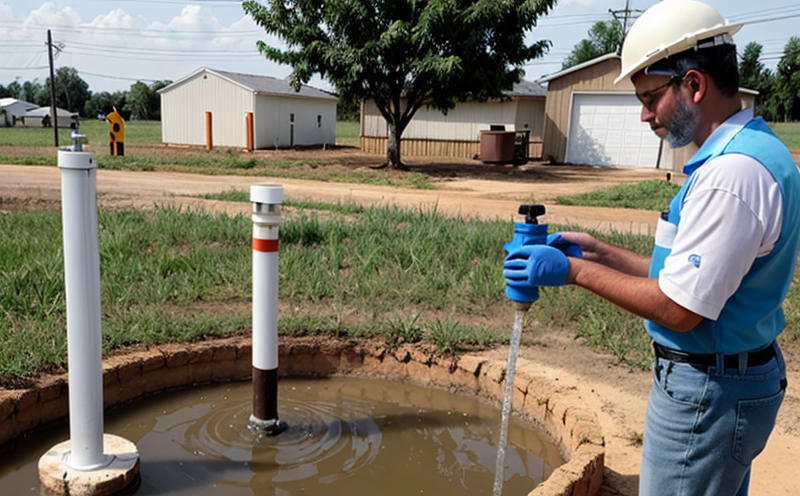EN ISO 15089 Acrylamide & Epichlorohydrin Testing
The European Standard EN ISO 15089 specifies the procedure for determining acrylamide and epichlorohydrin in water. This test is crucial for ensuring that water supplies, especially those used by industries such as food processing, pharmaceuticals, and chemical manufacturing, meet stringent quality standards. Acrylamide and epichlorohydrin are known carcinogens; their presence in drinking or process waters can pose significant health risks.
This testing is particularly relevant for the water & wastewater sector where compliance with international standards such as EN ISO 15089 ensures that water quality meets both regulatory and operational benchmarks. Quality managers, compliance officers, R&D engineers, and procurement personnel must be aware of these parameters to maintain a safe and compliant supply chain.
Acrylamide and epichlorohydrin are often used in industrial processes or can enter the water system through various sources such as chemical spills, improper disposal, or industrial effluents. The testing procedure outlined in EN ISO 15089 involves several key steps including sample collection, pretreatment (if necessary), extraction of analytes, and analysis using high-performance liquid chromatography with UV detection.
The test is critical for industries where water quality can impact product safety or worker health. For instance, food processing plants must ensure that their water supply does not contain acrylamide, which can form during certain cooking processes like frying or baking. Similarly, pharmaceutical manufacturers need to avoid epichlorohydrin contamination as it can interfere with drug efficacy and safety.
The testing procedure is designed to be robust yet precise, allowing for accurate quantification of these compounds even in low concentrations. The methodology involves the use of specialized extraction techniques followed by chromatographic separation and detection. This ensures that minute traces of acrylamide or epichlorohydrin are not missed.
The importance of this test cannot be overstated, especially considering the potential health risks associated with these compounds. Compliance with EN ISO 15089 is mandatory in many countries, and failure to meet standards can result in severe legal and operational consequences. Industries that rely on water quality testing for regulatory compliance should prioritize this service.
The test results provide critical data that can influence process control strategies, raw material selection, and ultimately product safety. By ensuring that the water used in industrial processes is free from these harmful compounds, companies can protect their employees and consumers while also maintaining a positive corporate reputation.
Scope and Methodology
| Parameter | Description | Method |
|---|---|---|
| Acrylamide (μg/L) | Measures the concentration of acrylamide in water samples. | High-performance liquid chromatography (HPLC) with UV detection. |
| Epichlorohydrin (mg/L) | Detects epichlorohydrin levels to ensure compliance with regulatory limits. | HPLC followed by derivatization for enhanced sensitivity. |
| Pretreatment | Involves sample filtration and conditioning before extraction. | Filtering through 0.45 μm membrane filters, pH adjustment if necessary. |
| Extraction | Extracts target compounds for analysis using solid-phase extraction (SPE). | SPE cartridges with specific sorbents to selectively extract acrylamide and epichlorohydrin. |
| Analysis | Analyzes the extracted samples to quantify acrylamide and epichlorohydrin concentrations. | HPLC with UV detection and mass spectrometry for confirmation. |
The process begins with sample collection, ensuring that it is representative of the water body being tested. Once collected, samples are prepared as per the standard procedure, which involves filtering to remove particulates and adjusting pH if necessary. Extraction using solid-phase extraction (SPE) cartridges ensures efficient separation of target compounds from matrix interferences.
The extracted compounds are then analyzed using high-performance liquid chromatography with UV detection for acrylamide and mass spectrometry for confirmation. The results provide precise concentrations that help in assessing the quality of water. This detailed methodology ensures accurate and reliable testing, which is vital for industries relying on safe water supplies.
Benefits
Compliance with international standards like EN ISO 15089 not only ensures that your organization meets regulatory requirements but also enhances its reputation. By using this service, you can:
- Avoid Legal Penalties: Ensure compliance and avoid the costly repercussions of non-compliance.
- Protect Employees & Consumers: Safeguard against health risks associated with acrylamide and epichlorohydrin contamination.
- Increase Operational Efficiency: Identify and rectify issues early, preventing costly shutdowns or product recalls.
- Enhance Product Safety: Ensure that your products are safe for end-users by using clean water supplies.
- Improve Environmental Stewardship: Minimize the risk of environmental contamination from industrial processes.
The service also provides critical data that can be used to improve process control strategies and raw material selection, leading to more efficient operations. By investing in this testing, you are making a significant contribution to maintaining high standards of water quality across your organization.
Why Choose This Test?
The EN ISO 15089 Acrylamide & Epichlorohydrin Testing service stands out for several reasons:
- World-Class Expertise: Our team of experts brings deep knowledge and experience in water quality testing.
- State-of-the-Art Facilities: Utilize cutting-edge laboratories equipped with the latest HPLC and MS technology.
- Precision & Reliability: The service provides accurate results that can be trusted for critical decision-making.
- Rigorous Compliance: Ensures full compliance with international standards, enhancing your organizational reputation.
- Customer Support: Ongoing support from our team to ensure you understand and utilize the test results effectively.
By choosing this service, you are not just meeting regulatory requirements but also investing in the future of your organization. The test results can guide critical operational decisions that impact both safety and efficiency.





